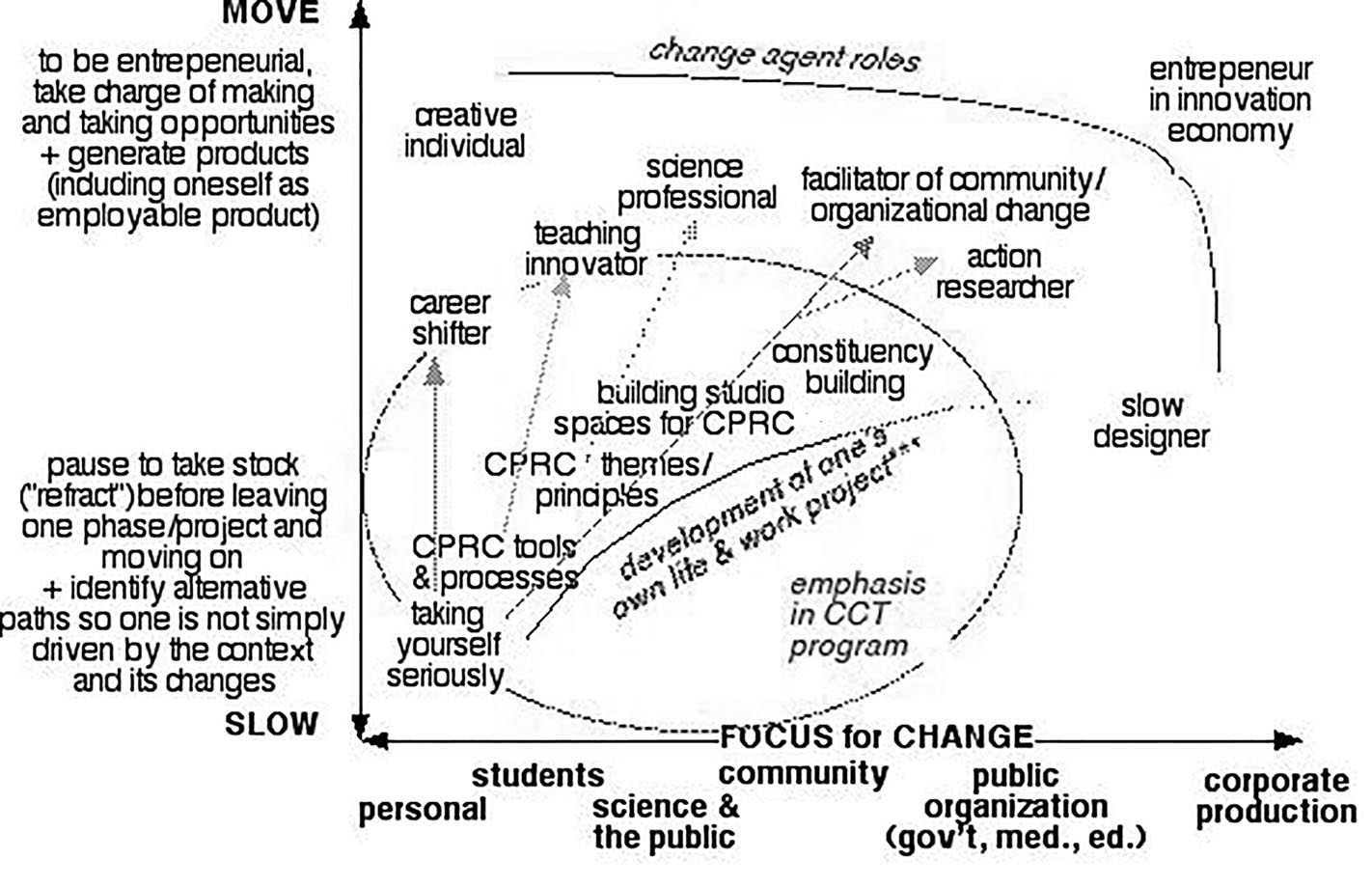SLOW MODE CO-COACHING
"If an Instructional Design graduate program produces graduates who work as instructional designers... what does a program in Critical and Creative Thinking produce?" The original version of this think-piece arose from Peter's musing on that question in 2014. It is included here because the components of the answer—the "slow mode" and "co-coaching" seem relevant to anyone working to take themselves seriously.
If an Instructional Design graduate program produces graduates who work as instructional designers, an applied sociology program produce graduates who are applied sociologists, and so on, what does a program in Critical and Creative Thinking (CCT) produce? What follows are a series of considerations that build up in due course to an answer.
First, note that the byline of CCT at UMass Boston reads: “Using critical and creative thinking to develop reflective practice as we change our work, learning and lives." The Program is really about changing practice; it might be called Critical, Creative, and Reflective Practice. Students come to the program with aspirations to move their work and other life projects in new directions or to a new level, or to clarify what they want their projects of professional and personal development to be.
Second, two modes of work and life can be contrasted. Students and graduates are developing their work and lives in a context in which they increasingly have to be entrepeneurial, take charge of making and taking opportunities, and generate products–including themselves as employable products. Let us, following Naveed (2014), call that the "move" mode of work and life. At the same time, in order to make best use of the one’s skills, experience, and aspirations, it is important to give oneself ample time for connecting, puzzling, reflecting, and creating (CPRC) or "taking yourself seriously." We can call that the "slow" mode (see epigrams to think-piece on Slow Ed Tech). To foster that mode, CCT introduces students to many and varied tools and processes, principles and themes, as conveyed in this book. Over the course of 2-5 years in Program, students build these into their own toolboxes and “studios” for lifelong learning and mindful or Refractice Practice. That is, before leaving one phase/project and moving to a new one, pause to take stock (“refract”) and identify alternative paths.
The contrast and the components mentioned in the previous paragraph are summarized in the figure below. (Taylor 2014 provides an animated and narrated version of the schema.)
 Slow versus Move mode in Personal and Professional Development
Slow versus Move mode in Personal and Professional Development
(See text and Taylor 2014 for elaboration)
The Program wants students not to be simply driven by context and changes. CCT as “education for critical, creative and reflective practice” spread out over a period of 2-5 years is meant to ensure that the slow mode is not eclipsed by the move mode, which often seems to happen. Indeed, a distinctive quality of the CCT education might be captured by inserting take the time it takes to between the words "we change" in the byline.
Third, CCT education aims to foster not only students' personal and professional development but also their ability to coach others in equivalent development. As stated in the CCT overview (CCT 2009):
an explicit and sustained focus on learning and applying ideas and tools in critical thinking, creative thinking, and reflective practice allows students involved in a wide array of professions and endeavors to develop clarity and confidence to make deep changes in their learning, teaching, work, activism, research, and artistry. By the time CCT students finish their studies they are prepared to teach or guide others in ways that often depart markedly from their previous schooling and experience.
Instructors in the Program also provide coaching, more than training. Given the wide range of students’ interests this is unavoidable. It is not possible to have, for each student, a faculty member specializing in their area of interest and able to model and mentor engagement and Action Research. Students and graduates have to bridge the gap between the slow mode using the general tools and processes for CPRC that CCT introduces and their individually specific work and life projects (i.e., the movement outwards beyond the circle in the schema above).
Fourth, limits and mutuality come into play. The combination of coaching with personal and professional development means that graduates as coaches also walk their talk. Similarly, instructors as coaches are committed to building and maintaining supportive spaces for their own diverse disciplinary and interdisciplinary research and engagement projects. When students see that, they can accept that
instructors have to set limits on the time they give to teaching, administering, and program development,
the Program will always therefore be a work-in-progress, and
instructors and students alike are teaching/coaching/supporting the work of others that is beyond their areas of comfort and competency.
This contrasts with expectations that instructors are:
experts with a polished package of up-to-date knowledge to transmit,
models of being in the trenches with students, making work and lives in the move mode, or
able to position the Program at the center of new move mode developments (whether that be MOOCs, TEDx talks, high-profile training, best selling books, etc.)
If the Teaching Mind invites life-long learners to view themselves as teachers, then students becoming coaches are invited to view their instructors through a "coaching mind." In particular, coaches—students and instructors alike—need always to be open to being coached.
Combining these four considerations, we have arrived at an answer to the original question. What a program in Critical and Creative Thinking (CCT) produces are “SloMoCoCos”—SLOw MOde CO-COaches.
References
CCT (Critical and Creative Thinking Program) (2008) "Overview." http://www.cct.umb.edu/overview.html (viewed 2 Sep 2008)
Naveed, N. (2014) "MOVE: Paradigm Shift of Creative Diversity" https://vimeo.com/99288456 (viewed 24 Sep 18)
Taylor, P. J. (2014) "Modes and Focus." https://www.youtube.com/watch?v=KzsoqKuq2QM (viewed 24 Sep 2018)
